We take a look at the importance of a good shipping policy, what to include, where to put it on your website, and some great examples of existing shipping policies. We’ve even thrown in a free shipping policy template to get you started!
What is a Shipping Policy and why do you need one?
A shipping policy is a set of guidelines – usually on your website – that details important shipping information for customers who make a purchase with you. A good shipping policy will contain everything your customers need to know in regards to shipping options and price, estimated delivery time, returns information, and more. Basically, everything your customer might need to know about your shipping policies in order to make an informed purchase.
Comprehensive shipping policies are important. Every eCommerce store should have one. Not only does a shipping policy create a better experience for your customers, it also establishes trust between businesses and customers. A detailed shipping policy improves your credibility, and makes customers more likely to buy from you.
Over 50% of shoppers will only buy goods online if delivery information is clear. (ReadyCloud, 2021)
Today, we’ll show you how to create a professional shippihttps://www.readycloud.com/info/your-guide-to-ecommerce-shipping-in-2021-2ng policy, where to place it on your website, show you some great shipping policy examples, and answer some of the common questions we get about them. We’re even throwing in a free shipping policy template to get you started on the right track!
In this article
How to write a shipping policy for your business
Once you know what to include, writing a good shipping policy isn’t particularly difficult. Let’s take a look at some components of a good shipping policy.
Order processing times
Customers are going to want to know how long it will take for you to process their order. For small items and orders, you should try and have processes in place that ensure all items get dispatched within a defined time frame.
Some items, such as furniture, might take a long time to process, or it might be difficult to give an exact timeframe. In this case, give your customers an estimation, but don’t overpromise. It’s much better to receive an order earlier than expected, rather than later!
Shipping options including costs
Not everyone can offer next-day delivery, but having multiple shipping options creates more flexibility for your customers and gives them a better experience shopping with you. Include shipping rates for each carrier / service, and provide an estimation of shipping timelines so your customers can choose the best shipping method for them.
You might offer free shipping to certain locations, or if a customer spends a certain amount. If so, be sure to highlight them, as it can benefit both your company and the customer!
Tip: Once an order is ready to be shipped, send your customers a shipping confirmation email. You can include all the relevant shipping details such as the estimated delivery date and tracking number.
National vs International shipping
If you offer international shipping, you should have a clear shipping policy for both national and international orders. Overseas and local shipping options will of course differ, both in terms of shipping rates and delivery times, so it’s important to cover both on your shipping policy page.
70% of online buyers already purchase from foreign sites. (eMarketer, 2022)
For multiple international shipping options, try and cover all the countries you sell to, with details of individual shipping charges, shipping methods, and shipping processes. It can be time consuming if you sell to a lot of countries, but it’s worth it as it shows every customer you care. Similarly, if a new customer stumbles across your products and cannot find their specific country, it will likely discourage them from buying from you.
Tip: International shipping can be confusing. There’s no need to get into the nitty gritty details on your shipping policy page, all your customers need to know is how long shipping will takes, shipping fees, and return shipping information. Check out our shipping policy template for examples.
Returns and exchanges
Offering returns will automatically make a customer more interested in your products. It provides a somewhat risk free way for them to buy from you, knowing that they can return the product if it’s not quite right, or if they change their mind.
Your returns policy should be clearly presented on your shipping policy page. Having a returns policy in place probably won’t have its desired effect if you give your customers a tonne of hoops to jump through to return an item, or if it isn’t clear under what circumstances an item can or cannot be returned.

Free guide
Plan for Peak
Peak is coming around fast! eCommerce retailers typically need to start preparing 2-3 months in advance to ensure a successful peak season. In our latest guide, we cover what you need to do to get ready for Peak.
You should let your customers know how long they have to return an item, details of return shipping, and when they can expect to receive a refund once you’ve received their return.
Some businesses may opt to have an exchange policy, in addition to, or instead of, a returns policy. Whatever the case, include your exchange policy under the same heading as your returns policy.
Click and collect
Some eCommerce businesses are in a position to offer a click-and-collect service on their orders. This can be beneficial to customers as it will usually be cheaper, with many companies offering free local pickup to reduce the burden of having it shipped out. It can be convenient for local customers to use click-and-collect to cut down the time it takes to receive an order.
If you offer click and collect, make sure to boast about it on your shipping policy page!
Cancellations
Similar to returns, customers will feel reassured when buying from you if you have an easy to understand cancellation policy. You may decide to offer free cancellations before the order has been dispatched, or before it’s begun being processed.
Whatever your cancellation policy may be, make sure your cut off times are clearly written into your policy to avoid any confusion or resentment.
Be sure to download our shipping policy template for further guidance on each of these sections.
Where to put your shipping policy
The most important thing about the location of your shipping policy is ensuring it’s easy to find. When building your website, you should build a specific page for your own shipping policy before the website goes live. Here are some tips to ensure your customers don’t get stuck when searching for your shipping policy:
- Stick it in the footer – It’s best practice to put all of your major pages in your footer, and your shipping policy is no exception. It can also improve your SEO, too, as Google will deem your website as more authoritative if it can easily find your shipping policy when crawling your website.
- Highlight it in your banner – If you offer customer-friendly shipping methods such as free shipping, show it off on your homepage. It can be a great way to entice customers. Similarly, if you’re expecting delays on order processing or shipping, it’s important to let them know here, too.
- Feature it on your product pages – It’s not uncommon to find shipping information built into product pages. Many eCommerce sites have all the relevant information baked into the template of these pages, often broken down into different tabs. This makes it easier to have bespoke shipping information per product, too.
- Include it on your FAQ page – FAQ pages usually get a lot of footfall, so having a link to your shipping policy on the page is a good idea. You can also highlight certain aspects of your shipping policy through FAQs, whether that’s free shipping over a certain amount, countries you don’t ship to, or circumstances in which delays might occur.
Examples of great shipping policies
We’ve had a look through some popular eCommerce business websites and thought we’d show you some of the best shipping policies we found.
Shipping policy FAQs – Argos
Argos is undoubtedly a giant in the world of eCommerce, so it makes sense that they’d have a pretty comprehensive shipping policy. One of the things we liked the most Argos’ policy is the drop down FAQ section which covers pretty much everything anyone could dream of asking about their shipping policy.
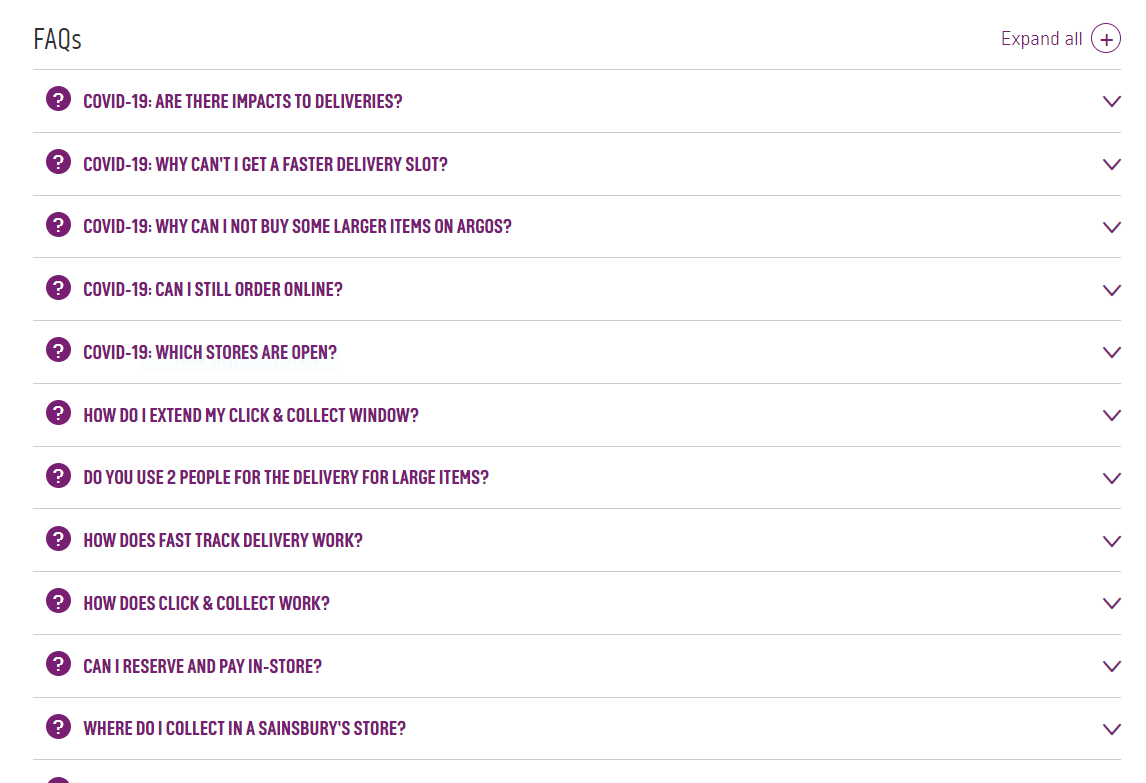
The power of the asterisk – GAME
Not only does GAME have a ton of delivery options to improve their customer experience, but they also put a handy asterisk next to relevant options to notify the customer that more information is available. We think this is a really nice touch to help customers find the information that is relevant to them.
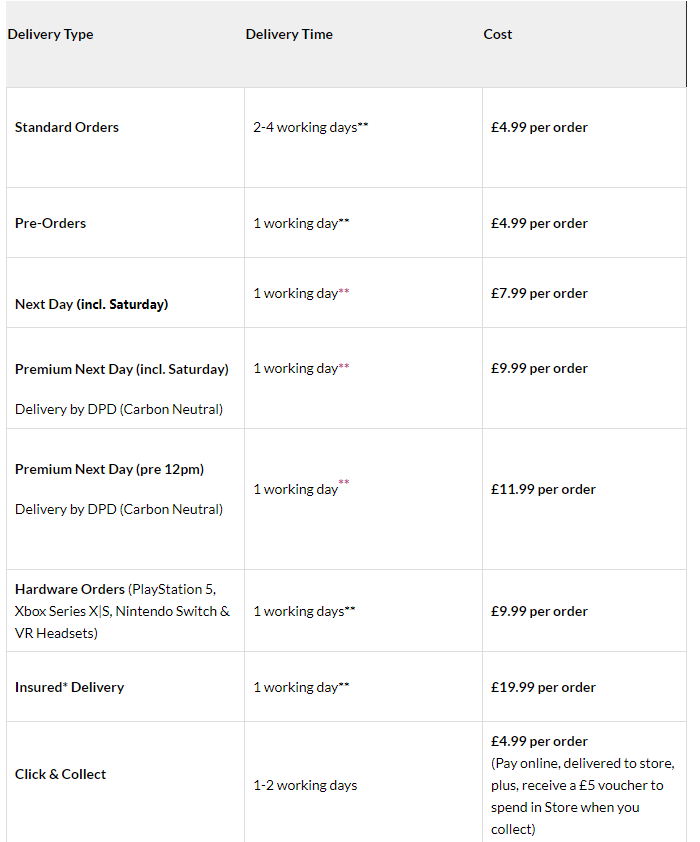
International shipping – ASOS
ASOS have an extremely user-friendly set up for how they go about shipping internationally. After clicking through to delivery information from the website footer, users are immediately given their home countries’ delivery information by default.
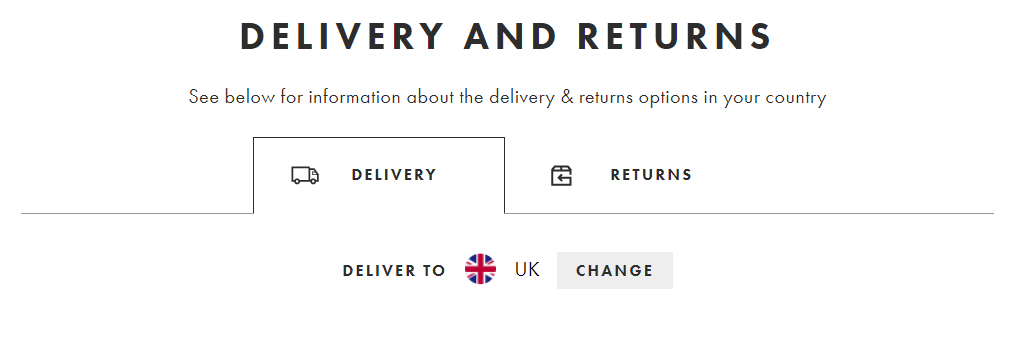
What we really liked, though, is how customers can simply click the ‘change button’ to be given a pop up list of all the countries ASOS deliver to, and a handy search bar so users can quickly find the country applicable to them. They’ll then be shown all the relevant shipping information.
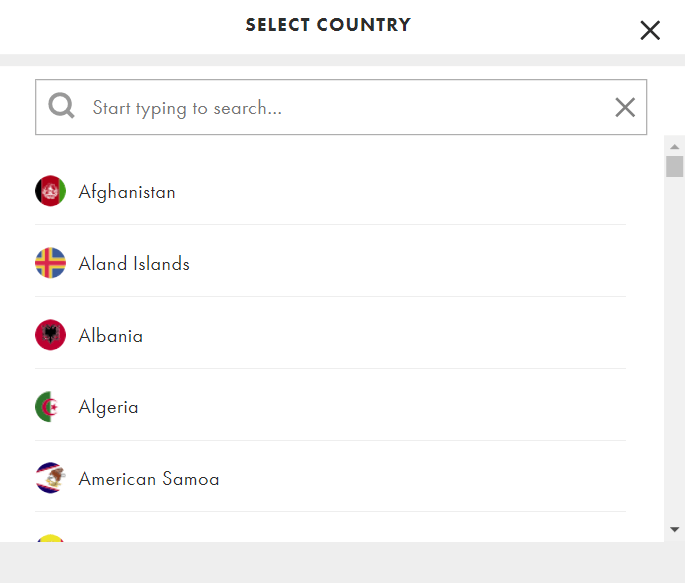
We also think the flags are a nice touch!
Quick links – DIXI
Dixi have taken steps to make their shipping policy extremely straightforward for their customers. Rather than having their entire shipping policy on the same page, Dixi have a list of quick links to direct customers to the most relevant piece of information for them.
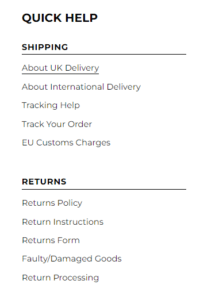
Eye-catching banner – Currys
At the top of their shipping policy page, Currys have an eye-catching banner that highlights a value proposition relating to their shipping. If your business offers benefits such as free delivery, bookable delivery times, next-day delivery and so on, be sure to brag about it either on your homepage or policy page.

Shipping Policy FAQs
What is a delivery policy and is this different from a shipping policy?
A shipping policy refers to your whole fulfillment policy, including shipping, delivery, returns, exchanges, etc.
A delivery policy may not be appropriate for all businesses, however, companies that provide a specialist delivery service may include a delivery policy within their shipping policy.
For example, if you are delivering large, heavy goods, your delivery policy might contain terms relating to the maximum distance you will deliver goods from a customer’s door or site. Similarly, if the customer isn’t home when the goods are delivered, your delivery policy may include redelivery charges, and so on.
Do I need a shipping policy if I use a 3PL provider?
Yes, you still need a shipping policy if you outsource your fulfillment to a 3PL provider. You should liaise with your 3PL provider to ensure they can meet the terms set out by your policy, and keep them informed should you make any changes to it.
How do I write a shipping policy for dropshipping?
A dropshipping shipping policy should include the same fundamentals as a regular shipping policy, but there are a few extra things to consider. Due to the nature of dropshipping businesses, your fulfillment times will likely be longer than average. You should make this clear in your dropshipping policy to avoid frustrated and disgruntled customers.
The second thing to consider as a dropshipping business is the timeframe of delivery for countries you get regular sales. Obviously, shipping times will vary between countries so you should include bespoke timeframes for each country you do business in. Finally, include an exclusion list for countries where you don’t offer shipping.
How often should I update my shipping policy?
As a rule, you should make a note to check in on your shipping policy every month or so to ensure that it’s up to date with the latest information. That being said, if anything changes between those check-ins, you should update your shipping policy to reflect the changes as soon as possible.
Common changes to review include shipping costs, shipping restrictions, free shipping thresholds, domestic shipping rates, shipping destinations, and so on.
Do I need a separate policy for domestic and international shipping?
You don’t need two different policy documents for domestic and international shipping. If you offer international shipping as well as domestic, just make sure details of each are included on your policy page. See our shipping policy template for examples.
Get your free Shipping Policy template
As promised, here’s your free shipping policy template to help you get started. Remember that a good shipping policy doesn’t need to be complex, just make sure you give your customers everything they need to know in the most convenient, concise way possible. You can always tweak and refine things as you grow and receive customer feedback.
At James and James, we help hundreds of businesses ship orders both domestically and internationally quickly and efficiently. If you’d like to find out about our award-winning technology and fulfillment service, please don’t hesitate to contact us. We’d love to chat about what we can do to help your business Scale Up.

 UK - English
UK - English
